90TH BOMB GROUP
"THE JOLLY ROGERS"
IN AUSTRALIA DURING WWII
![]()
| - 319th Bomb Squadron "Asterperious" - 320th Bomb Squadron "Moby Dick" - 321st Bomb Squadron "Bombs Away" - 400th Bomb Squadron "Black Pirate" |
The 319th Bomb Squadron was the first to arrive in Australia. They arrived at Amberley Airfield west of Brisbane on 23 October 1942 after a long 11 hour trip from Nandi on the island of Viti Levi in the Fiji Islands. They flew to Mareeba Airfield in north Queensland on 24 October 1942 after short stopover at Garbutt Airfield in Townsville. The B-24 of 1st Lt. Paul E. Johnson broke a rocker arm and had one of its engines fail as it approached Mareeba. It landed safely.
The 321st Bomb Squadron arrived at Amberley Airfield on 31 October 1942 . They had flown from Plaines desGaiacs airfield which is located 116 miles north west of Noumea, New Caledonia. The 321st Bomb Squadron flew to Mareeba Airfield on 1 November 1942.
One group of the 320th Bomb Squadron left Hawaii on 29 October 1942 with another group leaving on 1 November 1942. They followed the same route as the 321st Bomb Squadron.
The 320th had earlier flown from Long Beach Army Air Field, Long Beach California, via Hamilton Field, San Rafael, California to Hickam Field, Oahu, T.H., where they reported to the C G of the Hawaiian Defense Comman Theater. Crew No 68-Y-4 was first aircraft to fly the route. The second aircraft was flown by 2nd Lt John D. Ewing, details as follows:-
Crew No. 69-Y-3 B 24 D, #41-23915
Flight Order No. F-196
Project No MK 112nd Lt. John D. Ewing (0-433364) A.C. Combat Pilot
2nd.Lt. Fred Kettner (0-726413)A.C. Combat CoPilot
2nd Lt. Francis C. Sullivan (0-662109) Combat Navigator
2nd Lt. Donald M. Singer (0-661671) Combat Bombadier
S/Sgt. Roland C. Hickman (19062781) Combat Engineer
Sg. Ferenc J. Szabo (32338884) Combat Gunner
S/Sgt. James T. Zook (16065419) Combat Gunner
Cpl Winfield A. Lewis (35275624)Combat Radio Operator
Sgt. Walter P.Szeliga (36146599) Combat Gunner
Major John Donald Ewing
The 400th Bomb Squadron began leaving Hawaii on 31 October 1942 again following the same route as the 321st Bomb Squadron.
The 90th Bomb Group had arrived in Queensland with all of their forty-eight B-24D Liberators. They had not lost one single aircraft during their 5,000 mile journey, just a few minor incidents.
The ground echelon of the 90th Bomb Group left Honolulu Harbour at 11:00am on 8 November 1942 on board the SS Republic and SS Torrens. They were escorted by the battleships USS Colorado and USS Maryland and four destroyers. They arrived off Townsville in north Queensland on 24 November 1942. SS Torrens docked at the Townsville wharves on 25 November 1942. The men disembarked and were taken to Armstrong's Paddock, a US Army Staging area in Townsville.
Arlie Porter, was a member of the 320th Bomb Squadron. Arlie was in one of the first crews when the 90th Bomb Group formed in Barksdale Field, Louisana after it was initiated in Mississippi. He recalled arriving on a ship at Townsville and sleeping in a tent in a cow pasture, namely Armstrong's Paddock. Arlie only there for one or two days. He spent some time in Iron Range, then was stationed in Port Moresby as a member of Paul Gotke's crew on "Moby Dick".
The 90th Bomb Group was initially based as follows at Iron Range near the top of Cape York Peninsula, 16 kms inland from the port of facility of Portland Roads:-
| Arrived Iron Range | Departed Iron Range | |
| 319th Bomb Squadron | 13 Nov 42 | 2 Feb 43 |
| 320th Bomb Squadron | 13 Nov 42 | 21 Jan 43 |
| 321st Bomb Squadron | 19 Nov 42 | 10 Feb 43 |
| 400th Bomb Squadron | 13 Nov 42 | abt 22 Mar 43 |
When the 90th Bomb Group arrived at Iron Range, the two strips named Claudie and Gordon, were still unfinished and not sealed. Tents were pitched amongst the trees for accommodation. Conditions were primitive. Snakes, insects, scorpions, etc were prevalent. The men of the 90th Bomb Group described it as the worst airfield they were ever posted at during the war.
Possibly the Wiltse crew
in front of "Big Emma"
#41-23751 - "Big Emma"
Lt. Leroy Iverson with "Big Emma"
Crash of a B-24
Liberator at Iron Range
on 16 November 1942
11 men killed and 4 aircraft destroyed
On 16 November 1942 a Liberator crashed during take-off (see above) killing 11 men and damaging four aircraft. The first B-24 that took off on this raid on Rabaul, #41-11902 "Punjab", vanished without a trace on this mission. It was piloted by the Commanding Officer of the 320th Squadron, Major Raymond S. Morse. Also on board was the Group Commander, Colonel Arthur W. Meehan, who was co-pilot. This loss in combination with the above crash caused some significant morale problems amongst the men of the 90th Bomb Group.
The 319th Squadron moved to Fenton airfield south of Darwin. Fenton was named after Clyde Fenton, the Flying Doctor pioneer.
From the middle of 1944, the Liberators of 90th Bomb Group were a natural metal finish. They were adorned with the Skull and Cross Bombs markings of the Jolly Roger. The insignia was designed by Sgt. Leonard Baer. He made a large aluminium stencil. Each of the various Squadrons had a different colour background:-
319th Squadron Blue background
320th Squadron Red background
321st Squadron Green background
400th Squadron Black background
The nose of the Liberators in the 320th Squadron were painted with a shark's mouth. This was known as the "Moby Dick" squadron.
The "Jolly Rogers" were based at Iron Range for some time. They were also based a Fenton, 80 miles inland from Darwin.
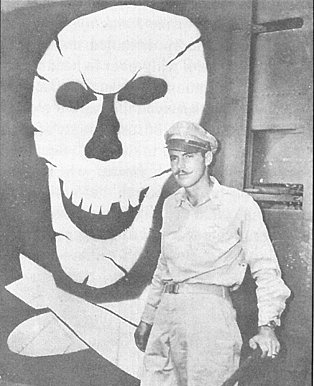 Art
Rogers and the famous Skull and Cross |
Colonel Art Rogers was the Commanding Officer of the 90th Bomb Group.
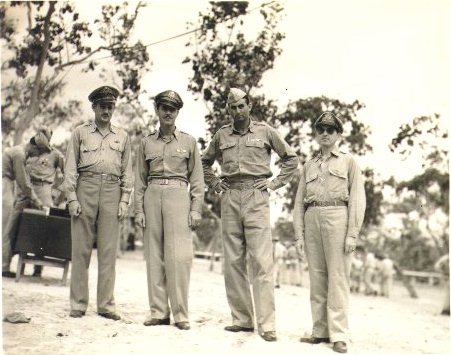
Photo:- from Bob Tupa
90th Bomb Group Awards Ceremony
Left to Right:- Possibly
General Ramey, Colonel Arthur (Art)
Rogers the Commanding Officer of the
90th Bomb Group, Major John "Big Jim" Davies, and Capt Norman Lawler the
90th Bomb Group Adjutant
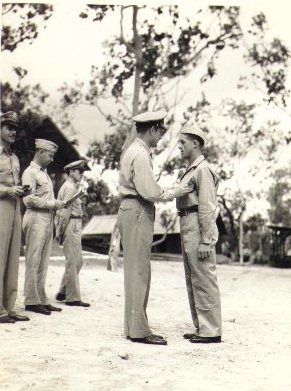
Photo:- from Bob Tupa
Earl Seeber
believes that the above recipient is his brother
Staff Sergeant William C. Seeber of the 400th Bomb Squadron who
died in New Guinea on20 June 1943 as a result of injuries sustained
when he was struck by a bomb trailer at APO 929.
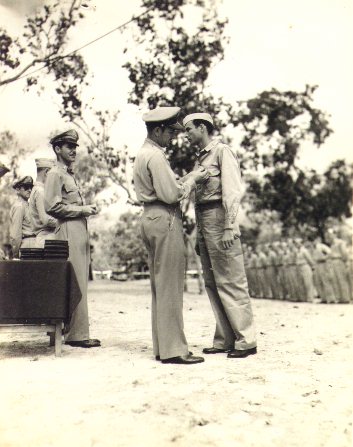
Photo:- from Bob Tupa
It was
initially believed that this may be T/Sgt Robert L.Wehrell
from
Midland Park, N.J receiving his medal. See paragraph below for more information.
Who is the person receiving the
above medal?
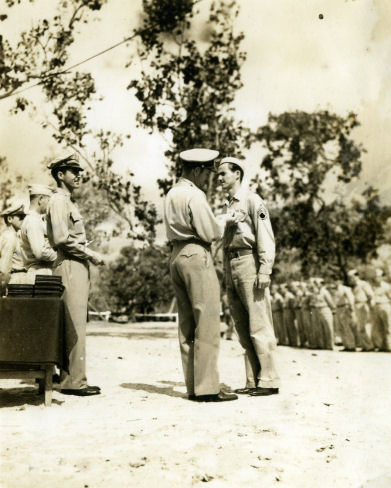
Photo:- via John Hillegass
Paul James Hillegass of the 319th Bomb Squadron,
90th Bomb Group. His son
John Hillegass told me that during WW2 his father received the Silver Star, DFC,
Air Medal,
and Purple Heart for service as a nose gunner on B-24s in the
South West Pacific Area
The sons of T/Sgt Robert L.Wehrell who is mentioned in the description under photo above, have now advised via Earl Seeber that they have a photo of their father being awarded the DFC and a newspaper article saying the award was made by Brig. General Roger Ramey. Neither the picture or the news article is dated nor is the date of the award ceremony mentioned in the article. One of the brothers told Earl that the background in the photo that they have is identical to the background of the photo above. One of the sons told Earl that he thought that the ceremony had probably taken place after 19 July 1943, the date of the General Order from the 5th Air Force listing the many men who would be awarded the DFC. His father's name was on that list. That order came ten days after he and the rest of the 319th Squadron were transferred back to Port Moresby, New Guinea from Fenton Field south of Darwin, Australia. They arrived in Port Moresby from Fenton on 9th and 10th of July 1943. The 319th had been flying out of Fenton since 2 February 1943 when they were split off from the other squadrons of the 90th BG based at Port Moresby and assigned to work with the RAAF command in the area of Darwin. One of the sons said "My father remembers that the ceremony took place in New Guinea but not the date". Can anyone please help sort out who the person is in the above photograph?
The following photographs from Bob Tupa are of aircraft that took part in the 16 November 1942 raid according to the list in Wiley Woods' book.
Capt Norman Lawler,
90th BG adjutant
in "Moby Dick" (possibly #41-24047)
Crash of a B-24
Liberator "Little Eva"
near Burketown on 2 December 1942
Crash
of a B-24 Liberator at Iron Range, Queensland
on 26 December 1942, 10 killed
 As you can see, the Jolly Roger's squadron got all the limelight. Bob Hope was at Biak on 25 August 1944 putting on a special show for the Air Corps. He is seen in the "Jolly Rogers" staff car holding a captured Japanese flag which was presented to him. |
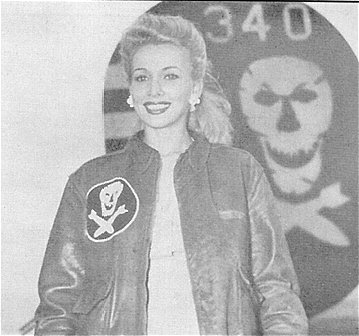 And it gets even better for the "Jolly Rogers" boys. Hollywood actress Carole Landis must've been a big hit with the boys of the 90th Bomb Group. Carole is standing in front of the tail of B-24J, #44-40340, "Buck Benny Rides Again" at Hollandia in August 1944. |
On 29 August 2000 I received an e-mail from Paul Holst who told me that he had been looking at this 90th Bomb Group web page with his uncle James Marvin Riggs from Versailles, Missouri, USA, who had served with the 320th Squadron from 1943 to 1946. When they got to the above photograph of Carole Landis wearing the flight jacket, Paul's uncle said he remembered her and he said, "that's my jacket." Paul thought that he just meant he had owned a jacket like that while he was with the 90th BG, but he said he was on the flight line the day that Carole Landis came out to the planes, (he refuelled the B-24s), and he had his jacket in his truck and lent it to the star to have her picture taken in. Paul Holst advised me in September 2007 that his uncle Marvin passed away in 2004.
Jack Benny in #44-40340
"Buck Benny Rides Again"
|
|
 |
|
|
 |
 |
 |
 |
These photographs are from "Doc" whose father was in the 320th Bomb Squadron of the 90th Bomb Group from April 1942 till the end. Unfortunately "Doc" did not tell me his name or his father's name. |

Photo: from John Farrell
319th Squadron being led by John Farrell headed for Balikpapan Borneo.
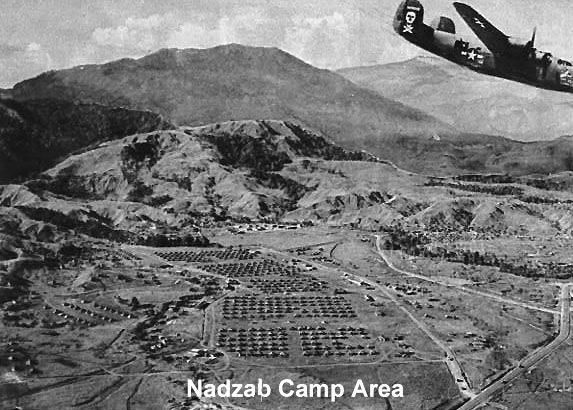
Photo: from John Farrell
View of the 90th Bomb Groups base at Nadzab, New Guinea.

Photo: from John Farrell
John Farrell is on the far left in the back row.
1st Lt. Albert F. Rogan
(Navigator) is the middle person in the back row. Usher Francis
(Tailgunner)
from Alto, Texas is the person in the middle of the front row.
On 15 October 2000, John Farrell told me that he landed his B-24 at Townsville in March 1944 before heading on to Nadzab, New Guinea to join the 90th Bomb Group. He stayed in Townsville for three days and he remembered it was the first time he had eaten steak and eggs. He also also dimly remembered taking a ferry to Magnetic Island off the coast of Townsville. He remember walking about town and over a bridge near the main street. The people were warm and friendly and he often wished he had gone back there after the war.
William R. Roedel was assistant ground crew chief in the 320th "Red Tails" for the aircraft nicknamed "The Dude". He painted the nose art on the plane. The pilot of "The Dude" was William Gentry who apparently looked like Clark Gable and wore buff yellow gauntlets while flying. William R. Roedel painted a top hat and cane along with the gauntlets as the nose art symbol. Gentry was later killed while flying a mercy mission in an SBD.
Earl E. Starkey, was a co-pilot in the 320th Bomb Squadron (and later in the 400th BS) of the 90th Bomb Group, beginning in September of 1943. He was initially part of the crew of Lt. H. C. Mills. In February 1944, he became ill and was in the hospital and recuperating in Brisbane for a long time in 1944. During that time, he met Olive Thomas Bradbury of Brisbane. Earl E. Strakey later returned to duty with the 400th BS of the 90th Bomb Group and was a relief pilot with a number of different crews until the end of the war. He brought his Australian bride back to the United States. Unfortunately and tragically, she contracted polio and died in San Antonio, TX, in 1953. Earl remarried and remained in the service and retired from the U.S. Air Force in 1969. In August of 1978, he died as a result of a prolonged fight with cancer.
On 9 July 2000, I was contacted by Richard G. ("Dick") Mills, brother of 2Lt/1Lt/Capt James E. ("Jimmy") Mills, pilot on a replacement crew that joined the 320th Squadron at Port Moresby in early/mid 1943. They flew out all their missions together, and rotated home together in March 1944. After his co-pilot Andy Muri got his own crew, 1/Lt Peterson became the crew's co-pilot. Other crew members were: -
Andy Muri, co-pilot
Stuart Hutson, navigator
Jim Young, bombardier
Frank Hornibrook, 1st engineer
Metzler 2nd engineer
Bronlett (Brenlett?), 1st radio
Streiter, 2nd radio
Dunbar, tail gunner
Wescott, nose gunner.
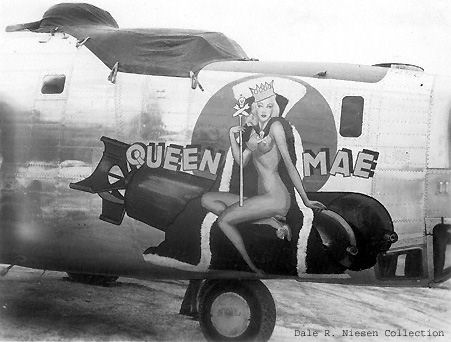
Photo:- Dale R. Niesen Collection
"Queen Mae" #44-40314" of the 319th Bomb Squadron, 90th Bomb Group
The following is from the Diary of Warren E. Rollins of "E" Battery of the 197 CAAA New Hampshire National Guard:-
Jan 2. 1943 The 400th' Bomb Group (sic Squadron) lost another plane at Port Moresby. It crashed on takeoff. There were six survivors.
Jan. 3, 1943 Hot and damp. I saw a P-39 a P-40 and a P-38 land today. It is the first time I have seen a P-38 on the ground.
Jan 5, 1943. We moved the tent closer to the gun pit today. My name was turned in to Battalion Hdqtrs today for promotion to Sgt. Hot and muggy. Had to spread crushed gravel on floor of tent. It was to muddy.
Jan. 10, 1943 A B-24 made a crash landing because the brakes didn't work and would have gone off the end of the runway into the trees. It landed on the tail with some damage.
Jan. 13, 1943 Test fired the guns in the gun pits. My machine guns fired good and checked out fine.
Jan. 16, 1943 The batry officers check the positions often. we know when they are coming
Jan. 18, 1943 Test fired the guns and then cleaned them. The guns are manned 24 hours a day I checked the guard lat 12;30 at night.
Jan 22, 1943 It is rumoured that the 90th Bomb Group is going to move to New Guinea and Us with them. The Japs bombed Milne Bay and port Moresby today.
Jan 2?, 1943. They gave us three cans of hot beer today.3.2 The first beer in 6 months for us.
Jan 26. 1943 I am in charge of the water for the gun crews this month. I picked up the barrels and filled them a the engineers place in the jungle.
Jan 26, 43 The roads are almost impassable because of the mud . It rains every day. We have to get the chlorinated water.
Jan 27, 43 We do have movies shown every night.
Feb. 4, 43 Test fired the guns/
Feb 7, 43 The 321st and the 318 (319th perhaps) Bomb groups (sic squadrons) moved today to NG
Feb. 8, 42 Had an air raid alert
Feb. 13, 43 It rains hard every day now that the monsoon season has started.
Feb. 13, 43 The 3 inch guns test fired today.
Feb. 24, 43 WE are able to jerry rig lights from the wire from all the wrecked planes here
Feb. 24, 43 We are getting ready for the new colonel to visit Iron Range soon. He will bring our payroll money. (Footnote This is the Colonel that was killed when the new plane crashed on the island.)
Feb 26, 43 Talked with Aussie friend today
Feb. 26, 43 A P-39 made a crash landing on Gordon strip. The front wheel was stuck. Not much damage. A P-39 while taking off on Claudia strip got a flat tire and skidded around. At this time most of the troops have left Iron Range for Port Darwin and New Guinea
March 6, 43 We are now attending classes on the 40 MM Bofor. They will issue them to us soon.
March 7, 43 We had an air raid alert this morning but no air raid
March 14, 43 It rained so hard today there was a foot of water on the runway. Our gun pits keep filling with water.
March 20, 43 Lt Richard Coughlin Inspected our guns. Sgt Clemons is on the other gun in my section.
March 10, 43 Cairns raided today 130 miles away. (Note:- I am not aware of any Jap raid on Cairns - Maybe it was a recce aircraft)
April 4, 43 We have a diet of kangaroo meat and wild boar.
April 9, 43 They are rebuilding the runways for heavy bombers now.
April 13, 43 Got a report that Japanese had landed 150 miles away. An un identified plane flew over all guns were alerted. There were two alerts yesterday
April 14, 43 Unidentified planes flew over the jetty. They expect air raids any time now
April 15, 43 Two more alerts today
April 16. 43 Yellow alert today plane 50 miles away
April 20, 43 Runways are ready for use. Two Bristol Beauforts and a DC3 landed on the new drome. The weather is fine now with a full moon and cooler. We are now able to listen to the Japanese stations on a radio now Tokyo Rose and she gives the name of our unit.
March 21,43 We loaded the btry onto a freighter at the jetty. The name of the boat that will take us to New Guinea is the Dutch Freighter the Duntroon.
E-Mails from Bob Tupa
The grandson of Captain Norman Lawler,
90th Bomb Group Adjutant
E-mails from Todd
& Polly Scott
Uncle was in 319th Bomb Squadron
E-mails from Susan
Wolfe
Daughter of Capt. John D. Ewing of the 320th Bomb Squadron
E-mails from
"Doc"
Son of a member of the "Jolly Rogers"
E-mails
from Jack
Demcovich,
son of Staff Sergeant John Charles Demcovich
of the the 319th Bomb Squadron
OTHER 90TH BOMB GROUP
HOME PAGES ON THE INTERNET
5th Air Force - 90th Bomb Group
On HeavyBombers.com
Can anyone hep me with
more information
and photographs of the 90th Bomb Group?
ACKNOWLEDGEMENTS
I'd like to thank Susan A. Wolfe, the daughter of Capt. John Donald Ewing, DFC of the "Jolly Rogers" for her assistance with this web page. Captain Ewing flew "Big Emma" from Long Beach Army Air Field, Long Beach California to Hawaii. It is unclear which aircraft he then flew through to Mareeba in Australia.
I'd also like to thank Bob Tupa, grandson of Capt Norman Lawler, the 90th Bomb Group Adjutant, for his assistance with this web page.
I'd also like to thank Earl Seeber, Paul Holst, Richard G. Mills, Randy Starkey and John Hillegass for their assistance with this web page.
I'd like to thank Jeff Slocum from Longview, Texas for his assistance with this web page.
I'd also like to thank Gerald N. "Jerry" Rogan, son of 1st Lt. Albert F. Rogan for his assistance with this web page.
REFERENCE BOOK
The Forgotten Fifth
"A Classic Photographic Chronology of the
Fifth Air Force in Action in the Pacific in WW2"
by Michael Claringbould
"Legacy of the
90th Bombardment Group - The Jolly Rogers"
by Wiley O. Woods, Jr.
Can anyone help me with more information?
"Australia @ War" WWII Research Products
|
© Peter Dunn OAM 2020 |
Please
e-mail me |
This page first produced 13 June 1999
This page last updated 23 February 2020